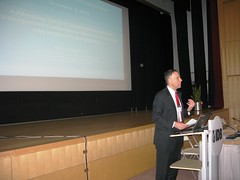
Alan N. Siegfried, Auditor General of the Inter-American Development Bank presented "Addressing Current Governance and Risk Management Challenges in Governmental and
International Organizations" at the ICGFM Winter Conference. The IaDB has been a prime mover in public financial management reform in Latin America and the Caribbean. He described the changes in the organization to improve the performance of the organization.
On a lighter note, Mr. Siegfried described the wonders of risk management thanks to George Costanza from the Seinfeld television series.
Mr. Siegfried described the current global economic challenges that generate uncertainty and unpredictability including turmoil in financial markets, changing regulatory environment and budget restrictions. Mr. Siegfried believes that this uncertainty presents the internal audit profession with an opportunity to demonstrate leadership in risk management, control and governance. He cautioned that internal audit is crucial to improve the credibility of governance structures. He warned the attendees that internal audit is often seen as inflexible and non-responsive to emerging risk. And, many organizations have cut disproportionately in oversight because of reduced budgets.
Mr. Siegfried described the important role of internal audit to help management identify risks, design risk management strategies, and monitor the effectiveness of control. He pointed He described lessons learned. Mr. Siegfried emphasized the differences between risk management, control and governance. He recommended that organizations must take some risk, otherwise the organization become stagnant.
Mr. Siegfried suggested that organizations must balance risk and opportunity. Risk management is about risk mitigation, not about eliminating risk. He described governance structures and the principles for enterprise risk management. He recommended more holistic views on risk management. He pointed out that Standard & Poors is now using enterprise risk management as part of organizational valuation.
Mr. Siegfried presented an overview of risk management for international organizations. He suggested that risk management does not need to be a centralized function. Accountability is critical regardless of whether centralized or decentralized risk management models are used.
He showed the roles that internal audit should take, could take and should not take in risk management. He spoke about risk velocity where problems can happen very quickly, like the earthquake in Haiti.
There is a significant value proposition to internal audit. Internal audit needs to move from recognized to trusted to valued. Mr. Siegfried provided an overview of the risk management evaluation framework. He provided a list of financial, compliance, strategic and operational risks to consider.
Mr. Siegfried concluded by suggesting that risks facing organizations are unprecedented and stakeholders’ expectations continue to increase. He recommended that individual practitioners and organizations must ‘raise the bar’ to most effectively represent and advocate for strong governance and risk management. Organizations need to move from hindsight to insight to foresight.
International Organizations" at the ICGFM Winter Conference. The IaDB has been a prime mover in public financial management reform in Latin America and the Caribbean. He described the changes in the organization to improve the performance of the organization.
On a lighter note, Mr. Siegfried described the wonders of risk management thanks to George Costanza from the Seinfeld television series.
Mr. Siegfried described the current global economic challenges that generate uncertainty and unpredictability including turmoil in financial markets, changing regulatory environment and budget restrictions. Mr. Siegfried believes that this uncertainty presents the internal audit profession with an opportunity to demonstrate leadership in risk management, control and governance. He cautioned that internal audit is crucial to improve the credibility of governance structures. He warned the attendees that internal audit is often seen as inflexible and non-responsive to emerging risk. And, many organizations have cut disproportionately in oversight because of reduced budgets.
Mr. Siegfried described the important role of internal audit to help management identify risks, design risk management strategies, and monitor the effectiveness of control. He pointed He described lessons learned. Mr. Siegfried emphasized the differences between risk management, control and governance. He recommended that organizations must take some risk, otherwise the organization become stagnant.
Mr. Siegfried suggested that organizations must balance risk and opportunity. Risk management is about risk mitigation, not about eliminating risk. He described governance structures and the principles for enterprise risk management. He recommended more holistic views on risk management. He pointed out that Standard & Poors is now using enterprise risk management as part of organizational valuation.
Mr. Siegfried presented an overview of risk management for international organizations. He suggested that risk management does not need to be a centralized function. Accountability is critical regardless of whether centralized or decentralized risk management models are used.
He showed the roles that internal audit should take, could take and should not take in risk management. He spoke about risk velocity where problems can happen very quickly, like the earthquake in Haiti.
There is a significant value proposition to internal audit. Internal audit needs to move from recognized to trusted to valued. Mr. Siegfried provided an overview of the risk management evaluation framework. He provided a list of financial, compliance, strategic and operational risks to consider.
Mr. Siegfried concluded by suggesting that risks facing organizations are unprecedented and stakeholders’ expectations continue to increase. He recommended that individual practitioners and organizations must ‘raise the bar’ to most effectively represent and advocate for strong governance and risk management. Organizations need to move from hindsight to insight to foresight.
Siegfried addressing current governance and risk management challenges in governmental and international organizations
View more presentations from icgfmconference.
Siegfried relever les défis de la gouvernance et de la gestion de risques actuels dans les organisations gouvernementales et internationales
View more presentations from icgfmconference.





No comments:
Post a Comment